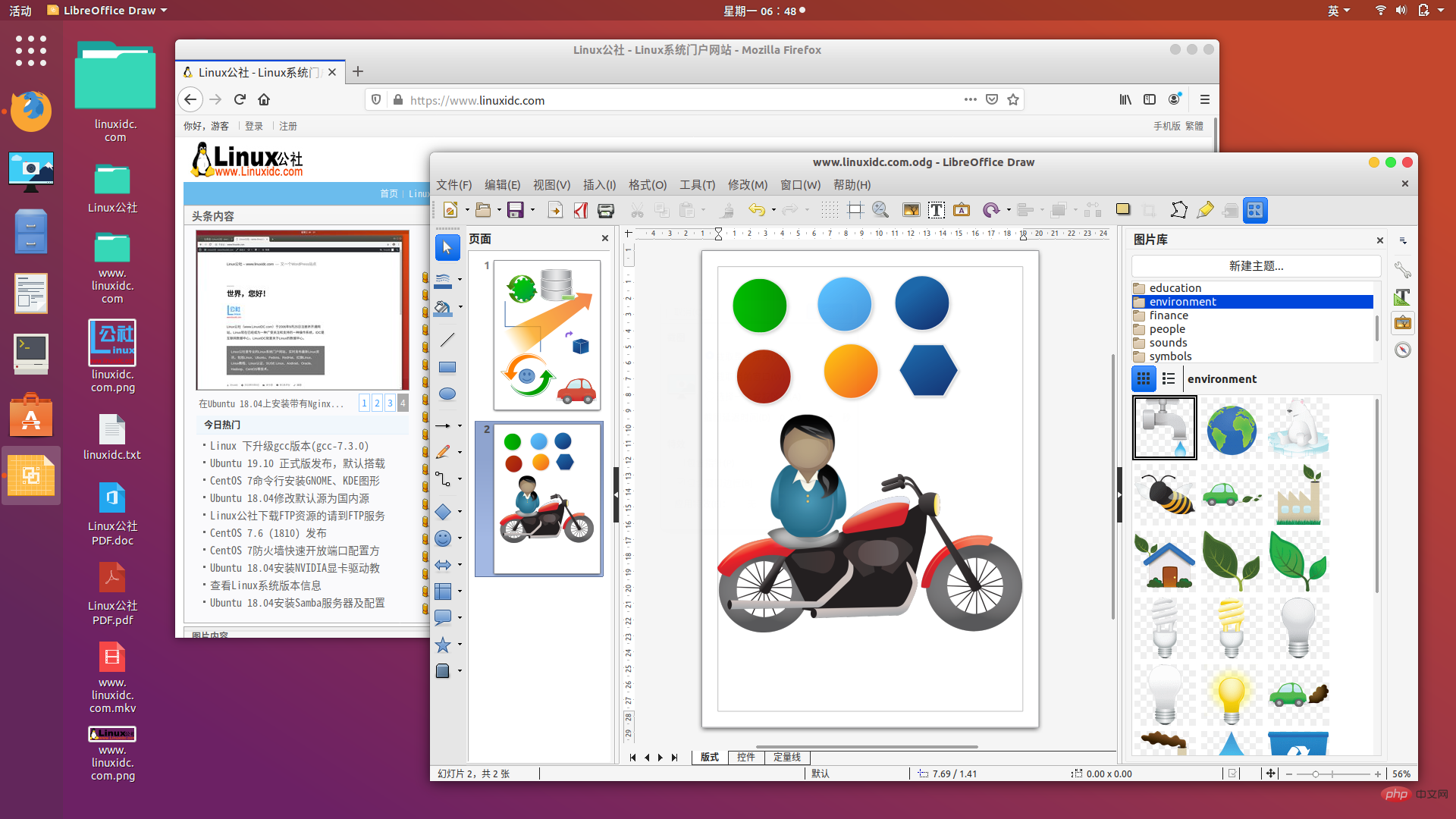 Operation and Maintenance
Operation and Maintenance
 Linux Operation and Maintenance
Linux Operation and Maintenance
 What are the flowchart software for Linux?
What are the flowchart software for Linux?
What are the flowchart software for Linux?
Linux flow chart software includes: 1. LibreOffice Draw; 2. OpenOffice Draw; 3. Inkscape; 4. Dia Diagram Editor; 5. Calligra Flow; 6. Pencil; 7. PlantUML, etc.

#The operating environment of this tutorial: linux5.9.8 system, Dell G3 computer.
Linux flowchart and diagram software
1. LibreOffice Draw
Draw is feature-rich , extensible, easy-to-use tool, and an excellent tool for generating powerful and intuitive flowcharts, organizational charts, network diagrams, and many other types of graphics. It can also be used to work with pictures and images in a variety of ways, and can produce anything from quick sketches to complex graphics.
Draw is part of LibreOffice, a powerful and free office suite that runs on Linux, macOS, and Windows computers. It uses the Open Document Format (ODF) (.odg image extension) for Office applications.
Some of its features include shape and drawing libraries, spelling checker, hyphen mode and color replacement. Importantly, it supports importing, editing, exporting PDF, importing from several file formats, and exporting to GIF, JPEG, PNG, SVG, WMF, etc.
In addition, it supports Java macro execution, various extensions, and its filter settings can be configured using XML.

2. Apache OpenOffice Draw
OpenOffice Draw is a free application for drawing business processes and diagrams. It is one of the tools included in the Apache OpenOffice Office suite. Similar to the functionality of LibreOffice Draw, it supports different diagram types such as flow charts, organizational charts, network diagrams, etc.
It also supports a variety of styles and formats, allowing you to import and export graphics to all common formats (including BMP, GIF, JPEG, PNG, TIFF and WMF). There is also support for creating a working Flash (.swf) version.
3. yEd Graph Editor
yEd Graph Editor is a free, powerful and cross-platform desktop application for creating charts quickly and efficiently. It runs on all major platforms including Unix/Linux, Windows and Mac OS X. yEd supports multiple chart types, allowing you to create charts manually or import external data for manipulation or analysis.
It supports diagrams such as illustration types, organizational charts, mind maps, swim lane diagrams, ERD, etc. Its key features include an intuitive user interface, support for importing external data from Excel spreadsheets (.xls) or XML, automatic layout of diagram elements, and the ability to export bitmap and vector graphics such as PNG, JPG, SVG, PDF, and SWF.

4. Inkscape
Inkscape is a free open source, cross-platform vector graphics software with a simple interface, available under GNU/ Runs on Linux, Windows and Mac OS X. It is multilingual and highly customizable. You can use it to create various graphics such as flowcharts, illustrations, icons, logos, diagrams, maps, and web graphics.
It has functions such as object creation and processing, fill and stroke, text manipulation, rendering, etc. It uses the W3C open standard SVG (Scalable Vector Graphics) as its native format. With Inkscape, you can import and export to a variety of file formats, including SVG, AI, EPS, PDF, PS, and PNG. You can also extend its native functionality using add-ons.
Related: Inkscape 1.0 beta released, a lot of changes to note https://www.linuxidc.com/Linux/2019-09/160726.htm

5. Dia Diagram Editor
Dia is a free, open source, easy-to-use popular and cross-platform drawing software for Linux desktop. It also runs on Windows and Mac OS X. It is used to create over 30 different diagram types including flowcharts, network layouts, database models. Dia has over 1000 predefined objects and symbols and supports multiple import and export formats. For programmers, scripting can be done through Python.
6. Calligra Flow
Calligra Flow is an easy-to-use tool for creating diagrams and flowcharts. It is included in the Calligra Office Suite and is highly integrated with other Calligra applications. It supports various diagram types such as network diagrams, organizational charts, flow charts, etc.
7. Graphviz
Graphviz (graph visualization software) is an open source programmable graphics drawing software. It comes with a series of graphic visualization programs specified in DOT language scripts. Additionally, it features web and interactive graphical interfaces, as well as auxiliary tools, libraries and language bindings.
Graphviz is used to generate charts manually or from external data sources in several useful formats, including images and SVG for web pages, and Postscript for PDFs. You can also display the output in an interactive graphical browser.
8、Pencil
Pencil is a free, open source, easy-to-use tool for GUI (Graphical User Interface) prototyping, used to create mockups in popular desktop environments. It comes with many built-in shape collections (including Universal Shapes, Flowchart Elements, Desktop/Web UI Shapes, Android and iOS GUI Shapes) for drawing different types of user interfaces from desktop to mobile platforms.
Pencil also supports chart drawing and export to different output formats, including OpenOffice/LibreOffice text documents, Inkscape SVG and Adobe PDF, as well as inter-page links. Additionally, it integrates with OpenClipart.org, allowing you to easily find clip art from the Internet.
9. PlantUML
PlantUML is an open source tool for generating UML diagrams using a simple text description language. It is used for modeling, documentation and UML. It enables you to create beautiful, professional-looking drawings and technical designs. PlantUML has an intuitive syntax and is command line based, and can be used in conjunction with GNU Emacs organizational mode for writing technical documentation.
It supports UML diagrams such as class diagrams, sequence diagrams, collaboration diagrams, use case diagrams, state diagrams, activity diagrams, component diagrams, deployment diagrams and entity relationship diagrams.
You can also use it to create non-UML diagrams such as wireframe graphical interfaces, archive diagrams, specification and description language (SDL), ditaa diagrams, Gantt charts, etc. Additionally, you can export the output as SVG or PNG in LaTeX format.
10. Umbrello
Last but not least, we have Umbrello UML Modeller, which is a free, open source, cross-platform unified Modeling Language (UML) diagramming tool that runs on Linux systems, Windows and Mac OS X. It supports you in producing design drawings and system documentation.
Umbrello UML Modeller 2.11 supports different types of diagram types such as class diagrams, sequence diagrams, collaboration diagrams, use case diagrams, state diagrams, activity diagrams, component diagrams, deployment diagrams and ERDs.
Related recommendations: "Linux Video Tutorial"
The above is the detailed content of What are the flowchart software for Linux?. For more information, please follow other related articles on the PHP Chinese website!

Hot AI Tools

Undresser.AI Undress
AI-powered app for creating realistic nude photos

AI Clothes Remover
Online AI tool for removing clothes from photos.

Undress AI Tool
Undress images for free

Clothoff.io
AI clothes remover

Video Face Swap
Swap faces in any video effortlessly with our completely free AI face swap tool!

Hot Article

Hot Tools

Notepad++7.3.1
Easy-to-use and free code editor

SublimeText3 Chinese version
Chinese version, very easy to use

Zend Studio 13.0.1
Powerful PHP integrated development environment

Dreamweaver CS6
Visual web development tools

SublimeText3 Mac version
God-level code editing software (SublimeText3)

Hot Topics
 What computer configuration is required for vscode
Apr 15, 2025 pm 09:48 PM
What computer configuration is required for vscode
Apr 15, 2025 pm 09:48 PM
VS Code system requirements: Operating system: Windows 10 and above, macOS 10.12 and above, Linux distribution processor: minimum 1.6 GHz, recommended 2.0 GHz and above memory: minimum 512 MB, recommended 4 GB and above storage space: minimum 250 MB, recommended 1 GB and above other requirements: stable network connection, Xorg/Wayland (Linux)
 How to run java code in notepad
Apr 16, 2025 pm 07:39 PM
How to run java code in notepad
Apr 16, 2025 pm 07:39 PM
Although Notepad cannot run Java code directly, it can be achieved by using other tools: using the command line compiler (javac) to generate a bytecode file (filename.class). Use the Java interpreter (java) to interpret bytecode, execute the code, and output the result.
 vscode cannot install extension
Apr 15, 2025 pm 07:18 PM
vscode cannot install extension
Apr 15, 2025 pm 07:18 PM
The reasons for the installation of VS Code extensions may be: network instability, insufficient permissions, system compatibility issues, VS Code version is too old, antivirus software or firewall interference. By checking network connections, permissions, log files, updating VS Code, disabling security software, and restarting VS Code or computers, you can gradually troubleshoot and resolve issues.
 Linux Architecture: Unveiling the 5 Basic Components
Apr 20, 2025 am 12:04 AM
Linux Architecture: Unveiling the 5 Basic Components
Apr 20, 2025 am 12:04 AM
The five basic components of the Linux system are: 1. Kernel, 2. System library, 3. System utilities, 4. Graphical user interface, 5. Applications. The kernel manages hardware resources, the system library provides precompiled functions, system utilities are used for system management, the GUI provides visual interaction, and applications use these components to implement functions.
 How to use VSCode
Apr 15, 2025 pm 11:21 PM
How to use VSCode
Apr 15, 2025 pm 11:21 PM
Visual Studio Code (VSCode) is a cross-platform, open source and free code editor developed by Microsoft. It is known for its lightweight, scalability and support for a wide range of programming languages. To install VSCode, please visit the official website to download and run the installer. When using VSCode, you can create new projects, edit code, debug code, navigate projects, expand VSCode, and manage settings. VSCode is available for Windows, macOS, and Linux, supports multiple programming languages and provides various extensions through Marketplace. Its advantages include lightweight, scalability, extensive language support, rich features and version
 Can vscode be used for mac
Apr 15, 2025 pm 07:36 PM
Can vscode be used for mac
Apr 15, 2025 pm 07:36 PM
VS Code is available on Mac. It has powerful extensions, Git integration, terminal and debugger, and also offers a wealth of setup options. However, for particularly large projects or highly professional development, VS Code may have performance or functional limitations.
 What is vscode What is vscode for?
Apr 15, 2025 pm 06:45 PM
What is vscode What is vscode for?
Apr 15, 2025 pm 06:45 PM
VS Code is the full name Visual Studio Code, which is a free and open source cross-platform code editor and development environment developed by Microsoft. It supports a wide range of programming languages and provides syntax highlighting, code automatic completion, code snippets and smart prompts to improve development efficiency. Through a rich extension ecosystem, users can add extensions to specific needs and languages, such as debuggers, code formatting tools, and Git integrations. VS Code also includes an intuitive debugger that helps quickly find and resolve bugs in your code.
 How to check the warehouse address of git
Apr 17, 2025 pm 01:54 PM
How to check the warehouse address of git
Apr 17, 2025 pm 01:54 PM
To view the Git repository address, perform the following steps: 1. Open the command line and navigate to the repository directory; 2. Run the "git remote -v" command; 3. View the repository name in the output and its corresponding address.






